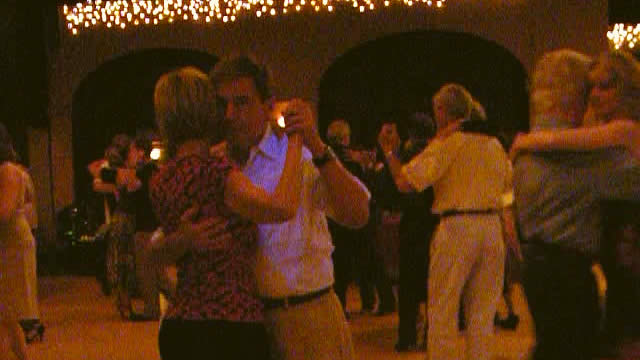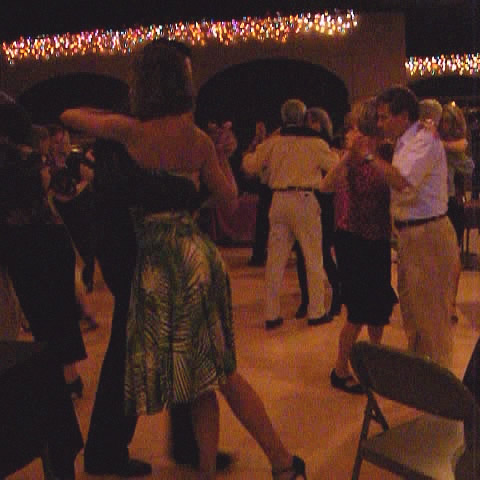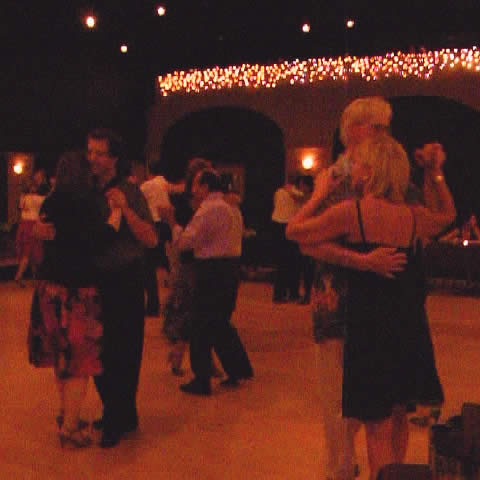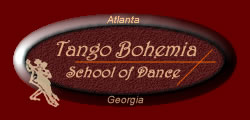Milonga Etiquette
Q: Is there a Milonga (Tango) Etiquette or set of rules?
A: Yes, there is. Please read about it below:

Dancing Tango at Milonga Bohemia in Atlanta
As Argentine Tango was created over 100 years ago, it had plenty of time to develop a set of customs that make good sense. Following the Tango Etiquette contributes to a happy and enjoyable dancing experience and makes people want to dance with you over and over again.
Wear clothing that makes it easy to dance, both for yourself and your partner. Avoid sleeveless shirts and strapped dresses, especially for active dancing. At milongas wear proper dance shoes, rather than sneakers or shoes with rubber soles. They can stick to the floor during turns and spins and cause ankle and knee injuries.
Leave at home big accessories: brooches, long necklaces, and big belt buckles: even big buttons on your dress or shirt can be uncomfortable for your partner. Leaders, please carry your keys or wallets in the back pocket of your trousers…
Followers, please be kind enough to put your long hair up or tied in a pony tail: long flowing hair gets caught and interrupts dance movements.

July '09 Milonga Bohemia
Dancing Tango is an activity where two people come in close contact, which suggests an importance of personal grooming and hygiene. It is always a good idea to freshen up before the dance, as well as avoid eating foods with strong flavors and smoking cigarettes. Many experienced leaders also carry an extra shirt with them to milongas, in case they need a change.
At Milongas
If you are new to tango and decide to attend your first milonga, please remember that all dancers who seem to you advanced started as beginners. It takes some time to get familiar and comfortable on the dancing floor. Your initial caution will pass soon, and you’ll be dancing as if it has always been your natural and only way of life.
At milongas take your time to observe the dance floor and moving couples. The dancing on a floor is done in a counter-clockwise direction, known as the Line of Dance. Dancers should stay away from the center space, unless they decide to do big figures in an open embrace. The dance line reminds one of a smooth water-flow with occasional slowdowns for a turn or two.
Some caution should be exercised when getting on the dance floor, especially if the song has already started and other couples are dancing. It is the responsibility of incoming couples to make sure that they stay out of the way of the couples already dancing. Do look at the leader in front of whom you are going to step on the floor and get their nod before entering. After a tanda (see below) is finished and before parting, thank your partner. If you enjoyed the dance, let your partner know. When a tanda comes to an end, leave the floor quickly and gracefully.
At milongas music generally is played in sets called “tandas.” It usually includes three to five songs played by the same orchestra. Milonga longer than 3 or 4 hours usually have longer tandas. Tanda is followed by a “cortina” (the curtain) which signals the end of a tanda. A cortina is your signal to smile, say ‘thank you’, and leave the floor.

May '09 Milonga Bohemia
In Argentina, leaders ask followers to dance with a certain glance, movement or nod of the head toward the dance floor or smile that says, “Dance with me?” This can take place from across the room if the right eyes are caught. If a woman wants to accept a dance with a man, she smiles back and keeps looking at him while he approaches her. This type of an invitation is called “cabeceo” (nod of the head).
The practice of asking people for a dance with cabeceo is followed in most dancing communities outside of Buenos Aires, Argentina. However, you may ask someone to dance directly. When asking for a dance choose simple traditional phrases as May I have this dance? Would you like to dance? Care to dance? Shall we dance?
Ladies, it helps to be social, smile back and show that you enjoy the invitation. Surely, if you choose to decline, it is acceptable to say, “No, thank you.” But if you accept a dance, remember it lasts for the remainder of the tanda. If either one of the partners decides that one or two dances are enough, either person can simply say “thank you” and gracefully begin leaving the dance floor. Please refrain from saying “thank you” before the end of a tanda if you want to finish it.
If you decided to decline an invitation for any reason, the etiquette suggests to sit out that tanda instead of dancing with someone else. It is also acceptable to agree to dance just one or two songs out of a tanda by saying it to your partner upfront.
Argentine Tango is an improvisational dance. It allows both partners to bring their own styles, music interpretation, and embellishments to the dance which contributes to the excitement of the experience. It is the surprise that makes tango addictive. It truly takes two to tango.
